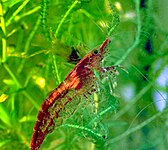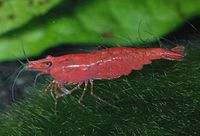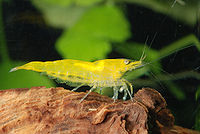Backstroke shrimp
| Backstroke shrimp | ||||||||||||
|---|---|---|---|---|---|---|---|---|---|---|---|---|

Back shrimp ( Neocaridina davidi ) |
||||||||||||
| Systematics | ||||||||||||
|
||||||||||||
| Scientific name | ||||||||||||
| Neocaridina davidi | ||||||||||||
| ( Bouvier , 1904) |
The cherry shrimp ( Neocaridina davidi , Syn. : Neocaridina heteropoda ), also Algengarnele , Invasionsgarnele or Guppygarnele called, is originally from East china native freshwater shrimp (Atyidae) from the genus Neocaridina .
Their keeping and reproduction in captivity is quite uncomplicated and, together with a red color form traded under the name “Red Cherry Shrimp” or “Red Fire Shrimp”, it has found widespread use in aquaristics in Europe . Since several representatives of the genera Neocaridina and Caridina are sold under the name back shrimp, it is often not easy to draw conclusions about their actual species affiliation.
distribution
In addition to its original habitat in lakes and small and medium-sized rivers in eastern China, the backed shrimp is now also found in other parts of China , in Japan , Taiwan and Hawaii . Within China, the species was brought to other inland waters with stocking fish from Lake Tai , while in Hawaii it was able to spread through the release of specimens originally offered as fish food. In Taiwan, the animals are also reproduced as fish feed. Since the back shrimp is robust against low water temperatures, there is a risk of reintroduction by former owners in Europe as well.
features
The color of the back shrimp is extremely variable and ranges from black, brown, red, dark green and light white to transparency. The proteins of the transparent specimens become opaque white through death. If a previously transparent shrimp appears slightly milky, it will die a little later. A drawing is possible, but not compulsory. A dorsal longitudinal line over the abdomen of the female animal, as it was named here, can also be found in many other freshwater shrimp and is not a sufficient species characteristic. The back line shrimp reaches a total length of up to 28.5 millimeters of which up to 6.5 millimeters the carapace is omitted. Male specimens usually stay smaller and are less plump than their female counterparts. The uropod fold is covered with ten to 21 thorns. In males, the ratio of length and width of the endopodites (paddle-like branches of the swimming legs) on the first pair of swimming legs is about 1.2. The edentulous tip of the rostrum does not extend beyond the end of the antenna base addition, the Rostrumformel is 2-3 + 7-19 (14-16) / 1-9.
Way of life
The peaceful and very adaptable species feeds on growth on rotting plant material as well as very small invertebrates and insect larvae. It reproduces during the warmer seasons. From the 20 to 50 approx. 0.55-0.58 x 0.85-1 millimeter eggs hatch the approx. 3 millimeter larvae, which are adapted to a soil-oriented way of life and which already have the body shape of the adult animals. Your upper body is initially colored white and the lower body is transparent. After a few days, the animals begin to change color slightly. Backstroke shrimp have a life expectancy of around 1.5 years.
Cultivated forms
Especially in the aquarium hobby , the already mentioned red ( Neocaridina davidi var. Red) and a yellow color form ( Neocaridina davidi var. Yellow) have developed, which are colloquially referred to as red fire or yellow fire . The latter can often be found in stores simply under the name yellow shrimp . Animals with a particularly closed coloration, including the extremities if possible, are called sakura (red) or neon (yellow). The word "sakura" comes from Japanese and means "cherry blossom" ( Japanese 桜 ).
More recently, an orange cultivated form has also been found in the trade under the name Orange Sakura . There are also discussions about a Black Sakura , i.e. a black cultivated form, but it is not clear whether it is a hereditary color variety. "Rili Red", "Orange Rili", "Carbon Rili" or "Rili Blue" - shrimp are also offered, which are also cultivated forms of Neocaridina davidi : Here the actual color of the shrimp is due to a pale white central part interrupted. A purely bluish form was selected from "Rili Blue" ("Blue Jelly" or "Full Blue Rili"). There is also a green color ("Green Jade").
Web links
- Neocaridina heteropoda inthe IUCN 2013 Red List of Threatened Species . Posted by: De Grave, S., 2013. Retrieved January 20, 2014.
- Species description at wirbellose.de
literature
- Andreas Karge, Werner Klotz: Freshwater prawns from all over the world. Dähne Verlag, Ettlingen 2007, ISBN 978-3-935175-39-5


